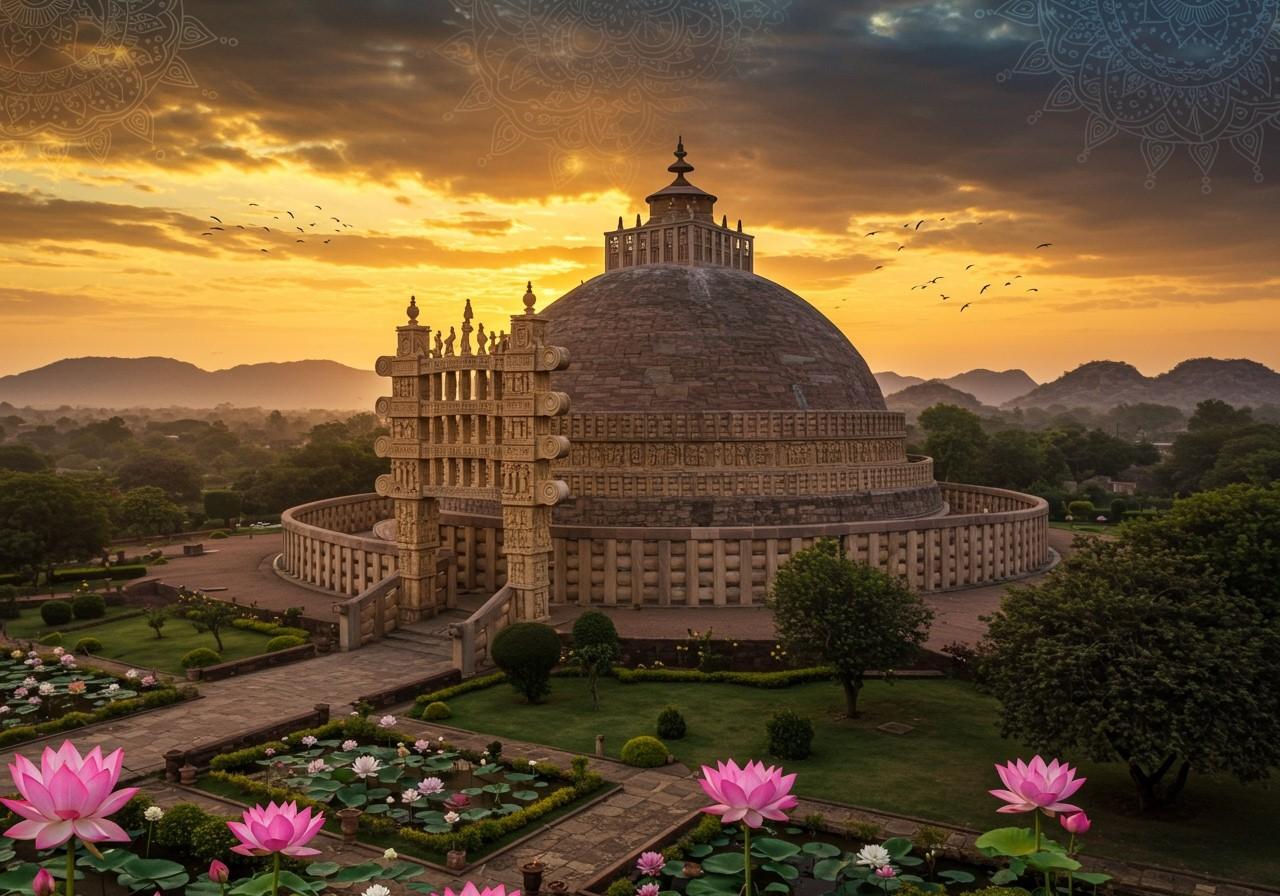
Sanchi, a small town in the Raisen district of Madhya Pradesh, India, is renowned for its ancient Buddhist site, featuring the UNESCO-listed Sanchi Stupa. This architectural marvel and World Heritage site stands as a testament to India’s rich cultural heritage and the enduring legacy of Buddhism. This ancient site is a must-visit for those who appreciate history and tradition. The Sanchi Stupa, constructed in the 3rd century B.C., showcases intricate carvings that depict Gautam Buddha’s life. The site also encompasses other attractions such as stupas at Sonari, Andher, and Satdhara, along with the Chetiyagiri Vihara, which safeguards relics of the Buddha’s disciples. Sanchi is easily accessible from Bhopal, the capital city of Madhya Pradesh.
Historical Background
Emperor Ashoka commissioned the Sanchi Stupa in the 3rd century BCE to enshrine the relics of Buddha. Ashoka played a pivotal role in propagating Buddhism across India. Enhancements during the Shunga (2nd century BCE – 1st century CE) and Satavahana (1st century BCE – 3rd century CE) periods further amplified its grandeur. The stupa’s gateways (toranas) and railings (vedikas) are not only architecturally significant but also artistically intricate. Rediscovered by British officer General Taylor in 1818, the Sanchi Stupa was later restored by Sir John Marshall in the early 20th century.
Architectural Splendor
The architectural features of the Sanchi Stupa include a hemispherical dome (anda), a central chamber (garbha), and a circular terrace (medhi). The toranas exhibit detailed carvings and motifs portraying scenes from Buddha’s life and Jataka tales. Symbolic elements like the harmika and chhatra underscore the stupa’s religious significance. Constructed from local sandstone, the craftsmanship is truly remarkable. The four gateways, each oriented towards a cardinal direction, play a crucial role in Buddhist rituals and processions.
Visitor Information
Sanchi Stupa is situated in Madhya Pradesh, India, approximately 46 kilometers from Bhopal. It is accessible by train, bus, or private vehicle. Visiting hours are typically from 6:30 AM to 6:30 PM. The best time to visit is during the cooler months (October to March). Guided tours and audio guides are available to enrich your experience. Nearby attractions include the Sanchi Museum and the Udayagiri Caves. Visitors are advised to dress modestly and adhere to photography guidelines.
Spiritual Significance
Sanchi Stupa holds profound spiritual importance for Buddhists, serving as a pilgrimage site. Rituals such as circumambulation (pradakshina) and meditation are common practices here. Annual events like Buddha Purnima draw devotees from all over the world. The stupa’s design and inscriptions reflect Buddhist teachings. The site offers a serene atmosphere, ideal for spiritual seekers and history enthusiasts.
Preservation and Conservation
The Archaeological Survey of India (ASI) and UNESCO are actively involved in preserving the Sanchi Stupa. Maintaining its structural integrity and artistic details presents ongoing challenges. The impact of tourism necessitates careful management and sustainable practices to ensure the site’s long-term preservation.
How Poojn.in Enhances Your Sanchi Stupa Visit
Poojn.in supports your spiritual journey to Sanchi Stupa by providing essential puja items and Buddhist offerings. As India’s largest Dashakarma bhandar, we offer authentic items required for Buddhist rituals and offerings at this sacred site:
- Pure Copper Water Vessels: Carry sacred water for offerings in our traditional tamra (copper) containers, known for maintaining water purity and enhancing the spiritual significance of your offerings. These vessels are crafted according to traditional methods, ensuring authenticity and reverence.
- Meditation Cushions: Find comfortable cushions ideal for meditation near the stupa’s peaceful surroundings. Our cushions provide the necessary support for extended periods of meditation, allowing you to fully immerse yourself in the serene atmosphere.
- Incense and Dhoop: We offer high-quality incense sticks and natural dhoop for making offerings, creating a fragrant and sacred ambiance during your visit. Choose from a variety of traditional scents to enhance your spiritual experience.
- Prayer Beads (Mala): Buddhist mala beads crafted from sacred materials are available for chanting and meditation, deepening your connection to Buddhist practices. Select from various materials and designs to find the perfect mala for your spiritual journey.
- Offering Plates: Traditional thalis and plates are perfect for presenting flowers, fruits, and other offerings with reverence and respect. Our offering plates are beautifully designed and crafted to enhance the sanctity of your offerings.
- LED Battery Diyas: Safe and convenient battery-operated lamps are ideal for evening prayers and create a warm, inviting atmosphere. These diyas offer a safe and practical alternative to traditional oil lamps, especially in crowded areas.
All items are available for home delivery across India through our website www.poojn.in. We ensure each product meets traditional specifications while being convenient for travel. Our customer service team can guide you in selecting the right items for your visit to Sanchi Stupa. Explore our collection of incense sticks, prayer beads, and other puja essentials.
Note: Please check local regulations regarding permissible items before carrying them to the monument site.
Conclusion
Sanchi Stupa stands as a testament to India’s rich cultural heritage and the enduring legacy of Buddhism. Its historical significance, architectural beauty, and spiritual importance make it a must-visit destination. By exploring Sanchi Stupa, you not only witness the grandeur of ancient craftsmanship but also connect with profound spiritual traditions. Whether you are a history enthusiast or a spiritual seeker, Sanchi Stupa offers a unique and enriching experience. Visit this remarkable site and immerse yourself in the tranquility and wisdom it embodies.
Learn more about other significant temples in India: Kandariya Mahadeva Temple and Mahavinayak Temple.


